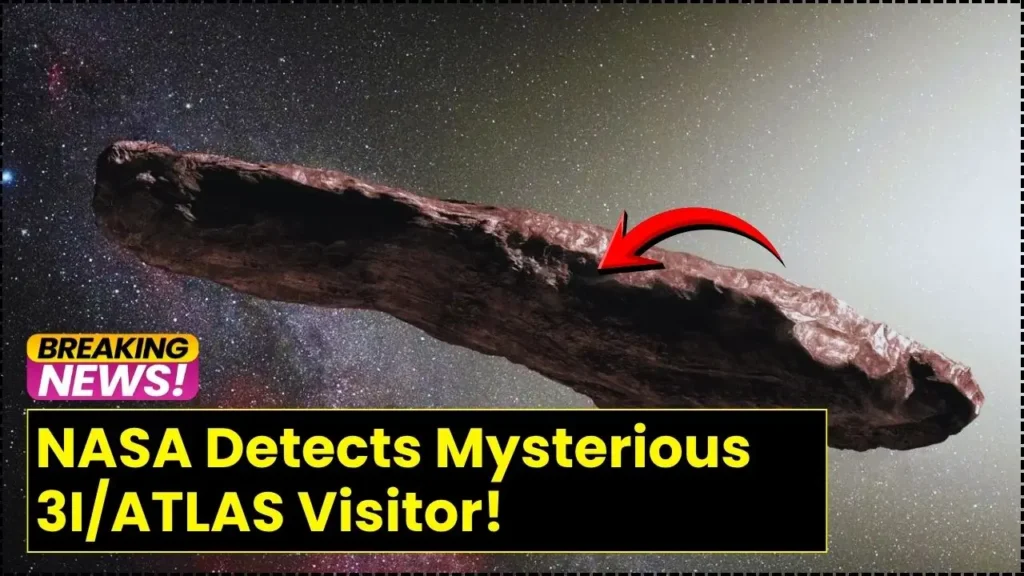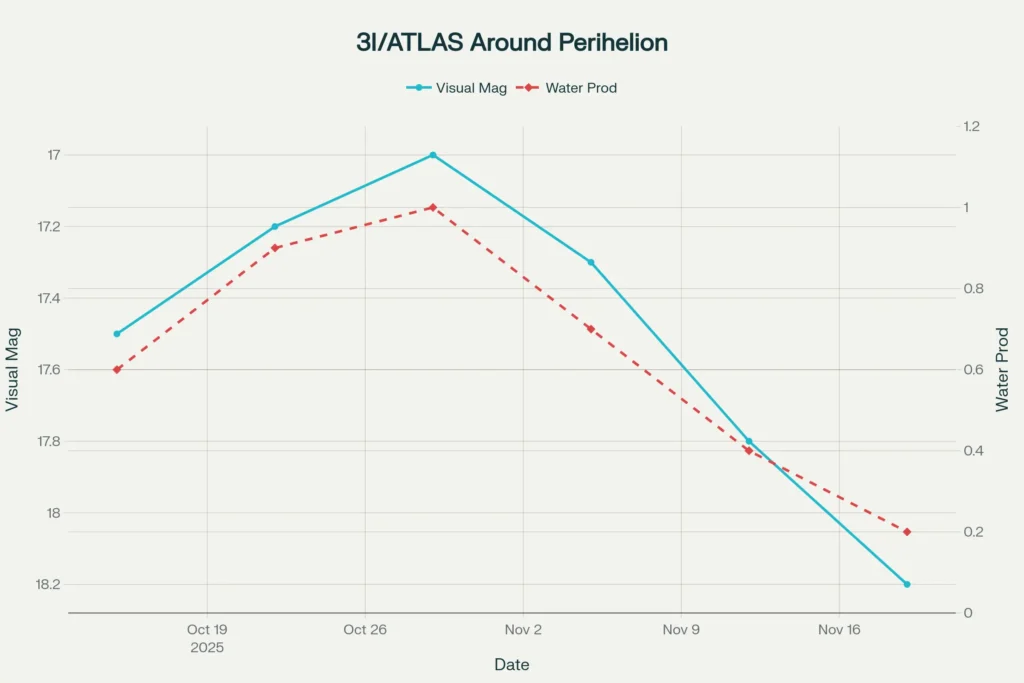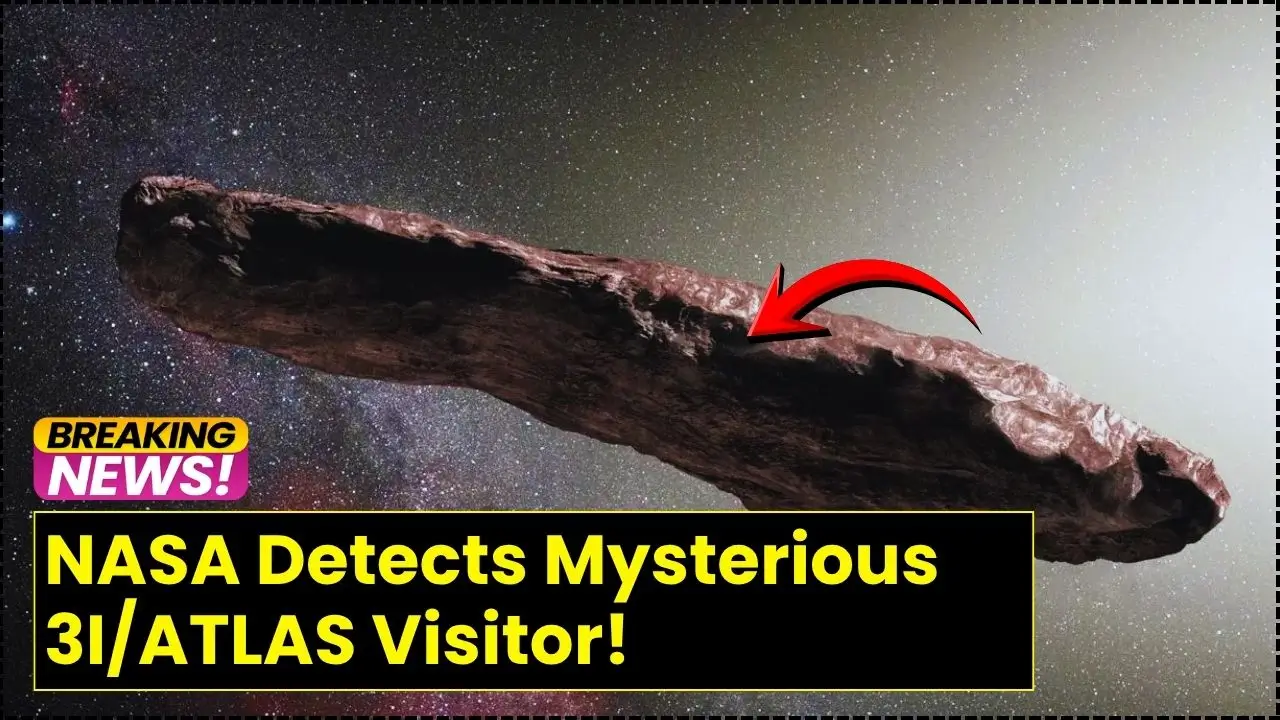Interstellar comet 3I/ATLAS has swung into the inner solar system on a one‑time, hyperbolic flyby, and it’s already rewriting expectations about how alien comets behave. Scientists are tracking a surge of unusual activity—powerful water release at unexpectedly large distances from the Sun and rare metal emissions that set this object apart from previous interstellar visitors. There’s no risk to Earth, but there’s a golden window for discovery as it passes perihelion and then reappears for fresh observations in the months ahead.

3I/ATLAS interstellar comet is only the third confirmed visitor from beyond our solar system, following 1I/ʻOumuamua and 2I/Borisov, yet it is carving its own scientific identity. It reached closest approach to the Sun around October 30, 2025, at roughly 1.4 AU just inside Mars’ orbit too far and too close to solar glare for naked‑eye views, but perfect for spacecraft and professional telescopes. Because the orbit is unbound and hyperbolic, it will not return; this is a once‑only chance to decode the chemistry and physics of an icy body forged around another star. 3I/ATLAS interstellar comet encapsulates why astronomers are excited: unusual water activity at large distances, metallic signatures in its coma, and an ideal timeline for coordinated observations across multiple observatories.
Table of Contents
NASA Detects Mysterious 3I/ATLAS Visitor
| Key Point | Details |
|---|---|
| Classification | Third confirmed interstellar object on a hyperbolic, unbound trajectory. |
| Discovery | Flagged on July 1, 2025, by the ATLAS survey; pre‑discovery images extended the observation arc back to mid‑June. |
| Perihelion | Around October 30, 2025, near 1.4 AU from the Sun; geometry makes it difficult for amateur viewing during peak activity. |
| Closest To Earth | Approximately 1.8 AU; no impact risk and not a naked‑eye spectacle. |
| Activity Highlights | Strong water release detected at large heliocentric distance; rare atomic nickel emission in the coma. |
| Imaging And Size | Space telescopes constrained a small nucleus and resolved a dust‑rich coma; detailed size estimates continue to be refined. |
| Visibility Timeline | Poor near perihelion due to solar glare; prospects improve for telescopic observers from November onward. |
| Scientific Payoff | Interstellar chemistry fingerprints, dust and gas evolution, and constraints on formation conditions in other star systems. |
3I/ATLAS interstellar comet is a mysterious, one‑pass visitor that’s safely bypassing Earth while opening a new chapter in comet science. The combination of early, vigorous water activity and rare nickel emissions provides a uniquely rich dataset to decode how icy bodies form around other stars and how they evolve during eons in interstellar space. It won’t dazzle the unaided eye, but for researchers and for sky watchers with the right gear—this rare traveler offers an unmatched chance to witness the chemistry and physics of a truly alien comet in real time.
A Strange Location for Water
What has scientists leaning forward is the scale and timing of water activity. Instruments have captured strong OH signatures—a chemical fingerprint of water at ranges where typical comets from our own system tend to be quiet. That implies sunlight may be heating small, lofted icy grains far from the nucleus, driving a vigorous, early coma. In plain terms: 3I/ATLAS is “switching on” earlier and more forcefully than expected, challenging standard models of when and how water sublimation ramps up.
Why The Object Stands Out
- It’s only the third interstellar object ever confirmed, giving astronomers a rare comparison set alongside ʻOumuamua and Borisov.
- Its chemistry is unusual: early, strong water activity and traces of atomic nickel in the coma suggest exotic formation conditions or long interstellar processing.
- The timing is excellent: a global network of telescopes and spacecraft can monitor the comet’s evolution before and after perihelion for a richer dataset than past visitors allowed.
Orbit, Timeline, And Safety
- The comet’s orbit is hyperbolic and unbound, confirming it originated outside the solar system and will exit permanently after this pass.
- It remains at a safe distance never closer than about 1.8 AU so there’s no danger to Earth and no reason to expect a bright naked‑eye display.
- As it moves away from the Sun in November and December, observing geometry improves, making it a better target for telescopes as glare subsides.
What Spacecraft And Observatories Are Doing
- Space‑based observatories with UV and infrared capabilities are watching perihelion and the weeks after, probing volatile species like water, CO2, CN, and trace metals that reveal the comet’s thermal history.
- High‑resolution spectrographs on large ground‑based telescopes dissect the coma’s composition, tracking how gas and dust output changes with solar heating.
- Coordinated campaigns are mapping jets, rotation, and dust production rates, providing clues to nucleus size, spin, and surface properties.
Chemical Signatures We’ve Never Seen
- Atomic nickel has been measured in the coma at relatively large solar distances, a tantalizing sign that 3I/ATLAS carries materials and textures not commonly documented in comets studied up close.
- The early, robust water signal akin to a “fire hose” suggests active mechanisms beyond simple surface sublimation, possibly involving fine icy grains launched from the nucleus and heated by sunlight.
- Together, these findings push comet science to revisit assumptions about activation thresholds, grain dynamics, and metal line formation in cold environments.
How It Compares To ʻOumuamua And Borisov
- ʻOumuamua was small, inactive, and puzzling no detectable coma and unusual non‑gravitational acceleration fueled extensive debate.
- Borisov behaved more like a classic comet with a volatile‑rich coma and tail, offering the first clear chemical snapshot of an interstellar traveler.
- 3I/ATLAS adds a new twist: early water activity at large distance and rare metal lines, broadening the known diversity of interstellar comet chemistry and behavior.

Observing Tips and Realistic Expectations
- Around perihelion, glare makes it tough for backyard observers; patience matters. Better windows open from mid‑November as the elongation improves.
- Even then, don’t expect a showy, naked‑eye comet. Think careful planning with a telescope, good charts, and dark skies to catch the subtle glow and evolving structure.
- Planetary missions and Earth‑orbiting observatories may release new imagery and spectra as the geometry improves, which can guide amateur campaigns.
Debunking The Alien Craft Rumors
- The data fit a natural comet: water and CN emissions, dust‑rich coma, and solar‑driven jets all align with known comet physics.
- Extraordinary does not mean artificial. Unusual does not equal engineered. The anomaly is scientific—timing, chemistry, and distance not a sign of technology.
- As more spectra publish, the narrative keeps consolidating around a natural interstellar comet with rare but explainable behavior.
Why 3I/ATLAS Matters for Planetary Science
- Each interstellar object is a sample from an exoplanetary nursery, a messenger carrying the mineral and volatile fingerprints of its birth disk.
- Understanding its dust, ices, and trace metals helps test models of how worlds form—and how their leftover building blocks evolve in deep space over billions of years.
- The campaign strengthens rapid‑response playbooks for future interstellar passersby, honing orbit prediction, spectroscopy, and hazard‑assessment tools that benefit planetary defense.
What To Watch Next
- Expect updated size constraints as coma modeling improves and as post‑perihelion views reduce glare, allowing better separation of nucleus and dust.
- Look for time‑series spectra mapping water, CN, CO2, and metals to track how the comet’s chemistry “breathes” with changing solar input.
- Watch for cross‑mission results where multiple observatories compare bands UV, visible, IR to build a fuller inventory of volatiles and grain sizes.
FAQs on NASA Detects Mysterious 3I/ATLAS Visitor
Is 3I/ATLAS visible without a telescope?
Not around perihelion. It’s too faint and too close to the Sun’s glare. Telescopic prospects improve after mid‑November as the elongation increases and it emerges from behind the Sun.
Is it dangerous to Earth?
No. It never approaches closer than roughly 1.8 AU. That’s hundreds of millions of kilometers away safe by any standard.
Why do scientists say it’s unique?
Because it shows strong water activity far from the Sun and rare atomic nickel lines in its coma both scientifically unusual and informative about its origins and long interstellar journey.
How does it differ from ʻOumuamua and Borisov?
ʻOumuamua looked dry and enigmatic; Borisov was a classic gassy comet. 3I/ATLAS mixes early water activation with metal signatures, expanding what’s possible for interstellar comets.

















